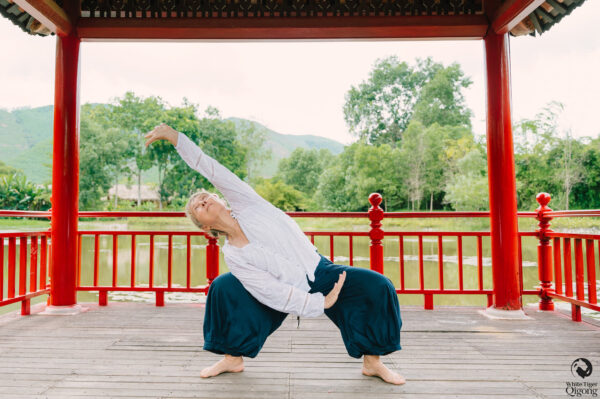The Fusion Debate: Exploring ‘Yogification of Qigong’
The recent dialogue within the Qigong community has highlighted a provocative term, ‘Qigong Yogification’—also known as the ‘Yogification of Qigong.’ This terminology has sparked intense debate, especially among some traditionalists who fear that such blending could dilute their cherished practices. But one might ask, do these purists truly grasp the depth of Qigong’s history? Are they aware that the intermingling of Eastern disciplines like Qigong and Yoga is not a novel concept but a continuation of millennia-old traditions of cross-cultural exchange and adaptation?
A thorough exploration of the historical and philosophical foundations of these practices not only supports such integrations but also elevates the ‘Yogification of Qigong’ as a significant historical continuation. This evolution, which spans over a thousand years, is not a fleeting trend but rather an extension of a deep-rooted tradition of cultural and spiritual synthesis.
The ‘Yogification of Qigong’ represents more than just a simple fusion of techniques; it signifies a thoughtful amalgamation that leverages the strengths of both realms. Diving deeper into this blend reveals its potential to enhance both spiritual and physical aspects of wellness, offering profound benefits to the contemporary wellness landscape.
Historical Synergies and Shared Philosophies
The historical narrative of the “Yogification of Qigong” underscores a millennia-old tradition of cross-cultural exchanges.
Qigong and Yoga, each rooted in rich historical and cultural traditions, offer unique paths to holistic well-being through the harmonization of body, mind, and spirit.
Qigong: A Pillar of Chinese Wellness Tradition
Qigong, with over 5,000 years of history, is a cornerstone of traditional Chinese medicine and Taoist practices, focusing on the cultivation of Qi (vital energy) through movement, breathing techniques, and meditation.
Yoga: India’s Ancient Gift to Holistic Health
Conversely, Yoga, born from the ancient Vedic scriptures of India, seeks enlightenment through physical postures, breathing exercises, and meditation, aiming to unite the body, mind, and spirit.
Silk Road: A Bridge Between Traditions
The cross-cultural exchanges between China and India, particularly through the Silk Road, facilitated a remarkable fusion of spiritual practices and philosophies. This period saw the merging of Buddhist teachings from India with existing Taoist and Confucian thought in China, notably influencing the evolution of Qigong. The historical exchange between China and India not only reveals the rich tapestry of cultural and spiritual traditions but also demonstrates how Qigong and Yoga have been open to transformation. This adaptability highlights their enduring relevance, as they’ve seamlessly integrated diverse elements over millennia, ensuring their practices remain vibrant and meaningful across generations.
The Renaissance of Integration in the 20th Century
The 20th century witnessed a renaissance in the integration of Qigong and Yoga, particularly through the emergence of Yin Yoga, which combines the gentle, flowing movements of Qigong with the discipline of Yoga’s asanas. This synthesis reflects a broader trend towards incorporating movement with static poses, grounded in the ancient traditions of Yoga and the Taoist practice of Dao Yin, predating the Han dynasty (168 BCE) (Kripalu).
In today’s wellness landscape, the “Yogification of Qigong” represents a modern synthesis tailored to meet current health needs. This approach leverages the mindfulness, breath control, and energy cultivation techniques from both Qigong and Yoga, illustrating a comprehensive method for enhancing personal well-being. Contemporary scientific research has begun to validate the physical and psychological benefits of these practices. Studies have identified distinct effects of Qigong and Yoga on heart rate patterns during meditation, suggesting their unique impacts on the autonomic nervous system. Further, research into the muscle activation patterns during specific Yoga poses offers insights into their potential for physical therapy and rehabilitation, enhancing core muscle function and addressing conditions like low back pain (Kripalu).
Scientific Validation of Combined Benefits
Contemporary research has begun to highlight the distinct benefits of integrating Qigong and Yoga, from impacts on heart rate patterns during meditation to potential advantages for physical therapy and rehabilitation.
The recognition of Qigong and Yoga in the West surged after China’s opening to the world, with significant figures introducing Qigong to the American public and highlighting its benefits alongside Yoga for stress relief, energy cultivation, and overall well-being. The complementary blend of strength, flexibility, and energetic flow found in both practices provides a holistic approach to wellness, inviting practitioners to find balance and harmony within themselves and with nature.
This nuanced understanding of Qigong and Yoga not only honors their historical roots but also acknowledges their evolving role in modern wellness paradigms, bridging ancient wisdom with contemporary scientific inquiry for a comprehensive approach to health and well-being.
The Modern Evolution: Integrating for Holistic Wellness
The modern wellness landscape is marked by a holistic approach to health, recognizing the interconnectivity of physical, mental, and spiritual well-being. In this context, the integration of Qigong and Yoga responds to a contemporary desire for comprehensive practices that address all aspects of health. This integration can be seen as a continuation of the historical tradition of cross-cultural exchange and adaptation, tailored to meet the needs of today’s practitioners.
Both Qigong and Yoga emphasize mindfulness, breath control, and the cultivation of energy, offering complementary techniques that can enhance one’s practice. For instance, the dynamic movements and energy work of Qigong can enrich the static postures of Yoga, introducing a flow of Qi that supports internal health and vitality. Conversely, the precision and depth of Yoga’s asanas (postures) can deepen the physical aspects of Qigong, promoting strength, flexibility, and balance.

The Call for Authentic Integration
The ‘Yogification of Qigong’ offers unique benefits, blending the dynamic energy cultivation of Qigong with the structured physical discipline of Yoga to create a holistic approach that enhances both physical and mental well-being. The key to a harmonious integration of Qigong and Yoga lies in respecting the integrity and origins of each practice. This requires a deep understanding of their principles and traditions, ensuring that their blending enriches rather than dilutes their essence. Practitioners and teachers alike must approach this integration with mindfulness and reverence, seeking to preserve the authenticity and depth of these ancient practices while making them accessible and relevant to modern lives.
Embracing Distinction, Not Dilution: The White Tiger Qigong Ethos
At White Tiger Qigong, we are deeply committed to bridging ancient practices with the forefront of scientific discovery. Our philosophy is not about blending Qigong and Yoga into one indistinguishable practice but rather about showcasing the unique strengths each has to offer and how they can mutually enhance and support a holistic approach to wellness. We honor the deep-rooted traditions of Qigong, ensuring that its teachings remain true to their origins, while also recognizing the valuable insights modern wellness approaches, including Yoga, bring to the table.
We stand firmly in preserving the potent essence that sets us apart. It’s about presenting Qigong and Yoga side by side, each retaining its unique qualities and benefits. Our philosophy rejects the notion of merging these practices into a diluted form. Instead, we focus on the complementarity of Qigong & Yoga — allowing each to shine and be honored on its own merit. This approach preserves the profound depth and integrity of White Tiger Qigong, ensuring that our teaching remains a pure testament to its origins and efficacy.
Our approach is built on a foundation of authenticity, striving for excellence in every aspect of our practice, and embodying compassion both in our teachings and in our community. By respecting the integrity of Qigong and appreciating the contributions of Yoga, we aim to empower our students, offering them a path to holistic wellness that is enriched by wisdom both ancient and contemporary. This philosophy is central to our mission, guiding individuals towards a balanced and harmonious state of being, where the cultivation of physical health, mental clarity, and spiritual growth are equally valued.
Conclusion: Embracing the Blended Path
The “yogification” of Qigong, rather than being a point of contention, should be viewed as an opportunity to explore the synergies between these powerful traditions. By respecting their origins and integrating their practices thoughtfully, we can offer a more comprehensive path to wellness that addresses the multifaceted nature of hu

man health. In this way, the blending of Qigong and Yoga is not a dilution but an evolution, reflecting our continuous journey towards understanding and achieving holistic well-being in the modern world.
Hearing directly from those who’ve experienced the transformative power of combining Qigong and Yoga can be incredibly inspiring. Wendy Jones, both a certified yoga teacher and Qigong teacher from Queensland, Australia, shares her personal journey, “After completing the White Tiger Qigong 5 Element Teacher training, I’ve woven this knowledge into my classes, taking them to a new height. The fusion of Qigong and Yoga has been perfect for wellness retreats and has resonated deeply with our guests.” Wendy’s experience highlights how integrating these practices can not only elevate your wellness routine but also provide a potent healing experience. Her testament to the decrease in lower back pain and the profound internal changes she observed speaks volumes about the synergistic power of Qigong and Yoga together. Join our community and discover the potent benefits of this combined practice for yourself.





